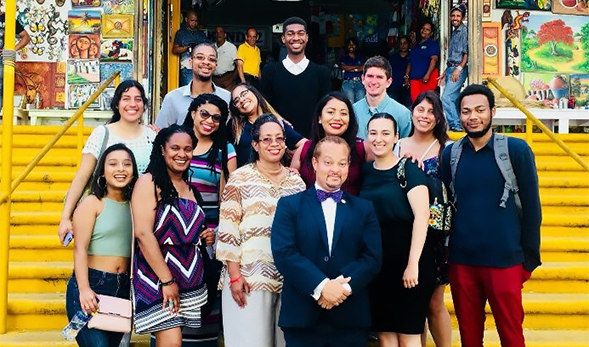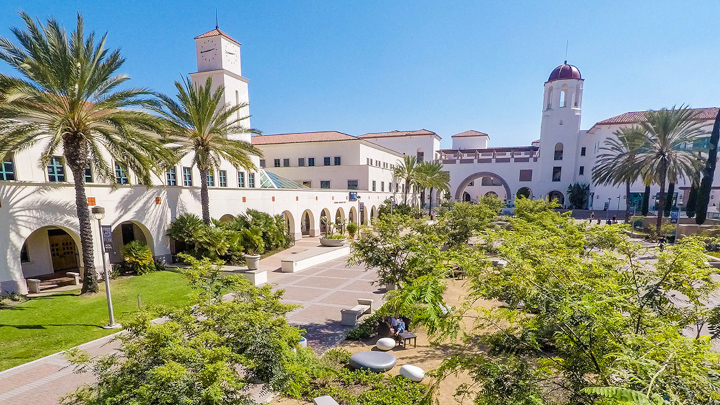Aztecs Abroad: Soy Americana
SDSU communication major Lorise A. Diamond is on a 16-day study abroad program in the Dominican Republic.

“Nevertheless, I was never prouder than the moment the airport attendant identified me as an American—wholly and unhyphenated—Solamente Americana.”
This summer, San Diego State University students studying abroad around the world are blogging about their experiences living in a new country. Check back each week to read their stories.
Title: Soy Americana
Author: Lorise A. Diamond, communication major, double minoring in sociology and honors interdisciplinary studies
Location: Santo Domingo, Dominican Republic
I know what the stereotypical American looks like. The country of my birth identifies me as African-American. My own country misconstrues my national identity. However, a passage in my passport “requests all whom may be concerned to permit the citizen/national of the United States named herein to pass without delay or hindrance and in case of need to give all lawful aid and protection.”
This is especially contemplative, considering how people of color are treated in the United States. Traveling abroad, I am no longer a suspicious, hyphenated or sub-American—I become a fully embodied U.S. citizen.
Preparing to board my flight from New York to Santo Domingo, my passport readied for inspection by multiple security and airline personnel, I took a deep breath and felt the heaviness of gravity weighing my feet to U.S. ground as I braved the jet bridge toward the plane. Three-and-a-half hours later, my passport received its first international stamp: Entrada, República Dominicana.
Waiting at the exit of the international disembarkation terminal of SDQ airport, one final checkpoint remained; “Cual es tu nacionalidad?” the Dominican duty officer asked. Before I could decipher the fluent Spanish being hurled at me, the airline attendant assisting me through customs answered, “Ella es Americana.” My face beamed proudly as the officer briefly scanned my passport, scrutinized my appearance, and then nodded for me to proceed through the terminal gate.
I blend in with Dominicans. Surrounded by people of color, I look like 99 percent of the people in the airport. The Islanders are proud descendants of multiple nationalities, primarily a mixture of Africa, Spain, and Italy. Asia, Denmark and France pepper the make-up of Dominican peoples due to both migration and colonialism. Despite this cultural cauldron, native-born citizens identify simply as Dominican. A hyphenated Dominican is unheard of. The duty officer’s question made me realize that I don’t look like the typical U.S. American citizen Dominicans might be expecting.
A byproduct of colonization, a skin-color hierarchy is apparent in the Dominican Republic. Haitian/Dominican relational tensions are high regarding Haitian immigration. Haiti—established through a revolution of African slaves who valiantly fought for their freedom—is one of the world’s poorest countries. Haitians are not welcome in the Dominican Republic, and there is political pressure to keep them out.
Typically, Dominicans speak a form of Spanish. Mostly, Haitians speak French. Possessing a mahogany complexion, Haitians are usually identified by their coarse hair texture and ebony-colored skin. Dominican legislative measures warrant the arrest and deportation of Dominican-born Haitians who are “returned” to Haiti, a country they have never known, inhabited by people who speak an unfamiliar language.
A color hierarchy based on the physical characteristics of skin color, hair texture and facial features is a complex cultural issue for Dominicans. One example of the color hierarchy is evident at Bahia Principe, one of the numerous Dominican tourist resorts. The manufactured festivities did little to mask varying degrees of Black servitude and its resultant color hierarchy. Employees who are darker-skinned or indio—as Dominicans refer to indigenous or dark-skinned people—work as cooks, landscapers and housekeepers (who wear uniforms straight out of an antebellum picture book). Those who have lighter skin work behind cash registers, reception and registration desks, serve food and drink (wearing modern, cruise ship type uniforms) and provide entertainment.
Furthermore, encounters with students—like the ones attending Sur Futuro—a high school located in Najayo, along with those enrolled a Catholic elementary school in Boca de Nigua, reveal the worst schoolyard insult: calling someone a Haitian—an allusion to being dark-skinned and poor.
Ultimately, I posit a question to Universidad APEC students in Santo Domingo: “Look at us,” I encourage, glancing around the room into the diverse faces of our SDSU study abroad group. “Do we look like the Americans you assumed were coming today?” An immediate and collective “No” met my query.
Traveling beyond my country’s borders, I embrace my rightful identity as a fully embodied citizen. Yes, the United States currently is grappling with its own growing pains, finding our way amidst a wave of white nationalism, complicated immigration issues, socioeconomic disparities, gender and skin color discrimination and more—just like the Dominican Republic.
Nevertheless, I was never prouder than the moment the airport attendant identified me as an American—wholly and unhyphenated—Solamente Americana.
For more blog posts from SDSU students studying abroad this summer, visit the SDSU Be International blog.


